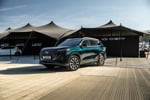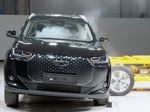The first quarter was disastrous, with sales plummeting almost 17% year-on-year caused by not having a C-segment car and issues with X-Trail run out. The second quarter saw barely any improvement.
In the second half of the year, sales recovered thanks to Qashqai and Navara (the signs are quarter four will be up more than 23% year-on-year), but the franchise will still fall short of the 100,000-plus sales target Nissan GB managing director Gary Frigo revealed to AM last year.
Retailers will end the year on 85,000 sales, down by less than 2,000 on 2006, but 17,000 fewer than 2005.
To counter dealer dissatisfaction with the franchise, which has seen several long-standing retailers leave over the past year, Nissan decided to share its three-year vision with the network. So far around 40 dealers have seen the plan; the rest of the 177-strong network will be shown the details in January as Nissan embarks on a two-week national roadshow.
It’s an aggressive plan based on 14 new launches. In 2010, Nissan wants to sell 122,000 units for a 4.6% share of the market – a rise on this year of 44%, or 37,000 units.
It’s not the only carmaker that wants to raise sales – they all do. So why does Nissan believe it will succeed?
Frigo says the new models are crucial. Most will be in new segments, following the example of the Qashqai. Some will be in conventional sectors where Nissan is not currently represented, with the focus moving away from 4x4s towards cars and LCVs. A small sportscar to rival the MX-5 is widely tipped by industry insiders.
“The strategy is to fit the consumer not the segments. Qashqai is an example of where Nissan is going,” says Frigo.
“Eighty-three per cent of Qashqai customers are conquests. We originally planned to sell 23,500 this year, which our dealers thought was crazy; we will actually sell 25,000 with a three-month waiting list.”
He adds: “We will build the franchise around Qashqai like Volkswagen has with the Golf. We are selling a high mix of higher trims – the average transaction price is £3,000 more than the Auris. “Qashqai is key for the future of the franchise.”
#AM_ART_SPLIT# Next year Nissan projects sales to rise by 8,000-10,000 to just short of 100,000. Much of the focus will be on the first quarter, scheduled to be up on 2007 by almost 45%. Second quarter should increase by 12%, quarter three by 9% and quarter four by 3%.
In addition to strong performers Qashqai, Navara and X-Trail, Nissan intends to do “a better job” with Micra, which dropped alarmingly this year. “We will be more aggressive on incentives and the way we use our money,” Frigo says. “We will sell more Micras in 2008.”
From next summer, Nissan’s product launch plan will see a new model come to market every 90 days. In 2010, the average age of the line up will be less than three years old.
With increased sales and higher trim mixes come improved profits for retailers. This year has been a struggle with first half profits down significantly. Frigo admits that Nissan is partly to blame but says some problems were unavoidable.
Part of the shortfall has been pulled back by a strong September and good final quarter, but the network average will still end slightly down on 2006, at around 1% return on sales.
Projections for next year see the network average rise to 1.3-1.5%. By 2010, retailers should average 2%. Frigo’s forecasts are based on this year’s performance for used cars (which he admits has been poor), no change in F&I, higher dealer overheads, a small rise in aftersales work and no change in new car profit margins. It’s all down to the increase in volume.
The inference is that dealers who make even small incremental improvements across their entire business should expect margins to exceed the 2% target average.
Standards and customer service are in the spotlight, both from a UK and global perspective.
Nissan will be launching a major quality initiative looking at vehicle quality and the customer experience. The UK will play a major role in developing and trialling the programme.
Nissan has also undertaken a study of its franchise standards. It relaxed some of its more controversial demands this year and is studying other standards, including the audit programme. “We believe our audits could be a bit excessive,” says Frigo.
He plans to grow the network from 177 to 195 dealerships by spring 2008, some of which will come from refranchising 10 of the 12 former Dixon’s sites. A full network will be 200-205 dealerships.
Some dealers have complained that Frigo and Nissan have not listened to their issues. He accepts the criticism, but says the situation is improving. “We have a completely new management team and then I wasn’t on the road or as accessible. Now I am,” he says. “I take pride in having good dealer relations. “We went into 2007 with dealers down. We will go into 2008 with dealers up after the second half success. They feel so much better about 2008 – and so do I.”
#AM_ART_SPLIT# A confused product strategy
Author: Roy Kishor, partner, Kroll
Nissan’s product strategy has no obvious theme: Micra, Note, Qashqai, GT- R are products that are discreet and separate propositions.
The range is made up of products that all say different things to the consumer, at a time when competitors are focused on product strategies that either keep the consumer with the brand as their needs change or enable them to find a product that suits them in a related brand.
It’s brave, counterintuitive and higher risk to do what Nissan is doing and Nissan’s brand strategy is confused and is dysfunctional alongside Renault.
Equally there is no obvious dealer strategy that ensures customers are managed within dealer groups to move from one related brand to another, as is the case, say, with VW and its portfolio of brands.












Login to comment
Comments
No comments have been made yet.